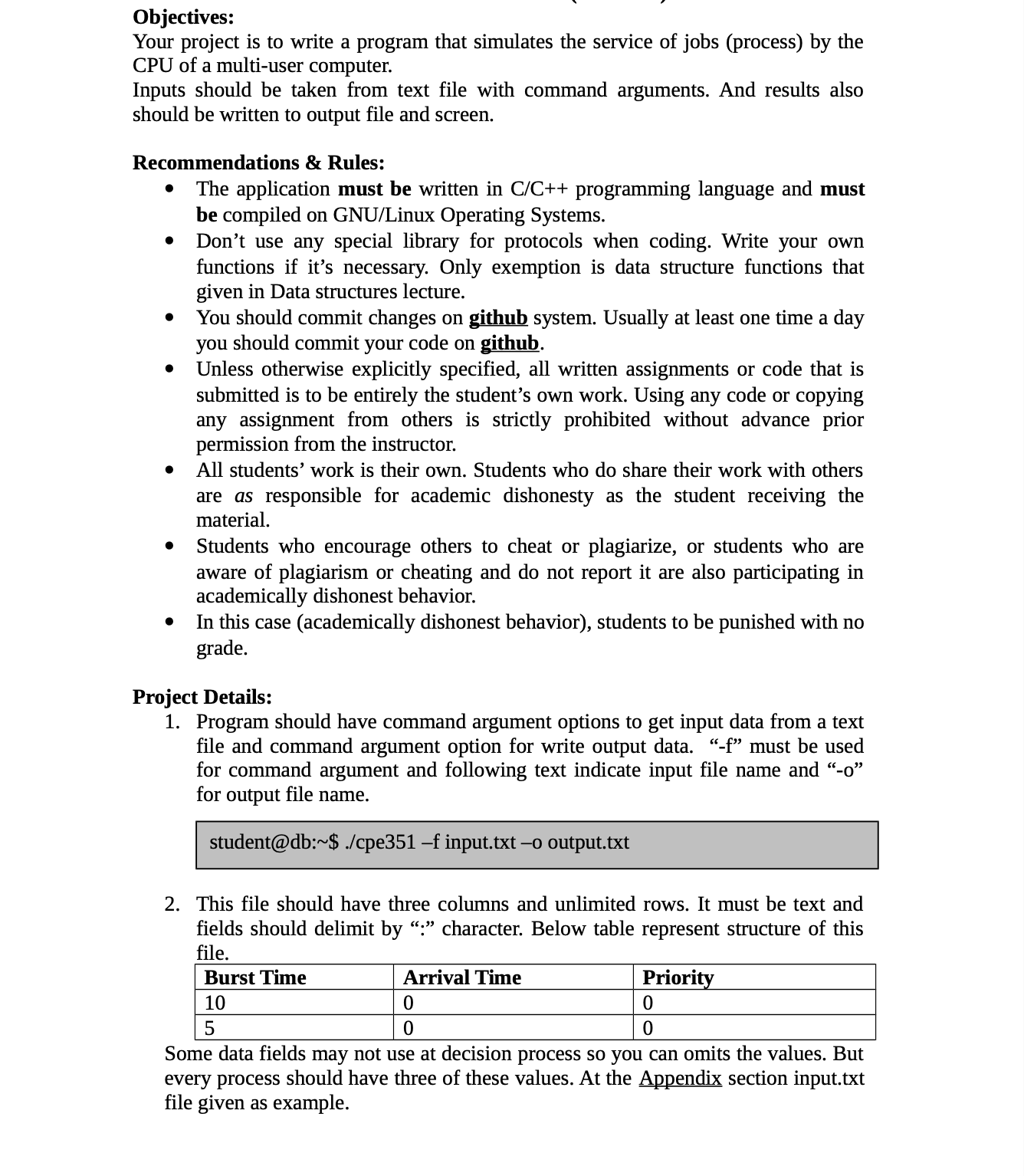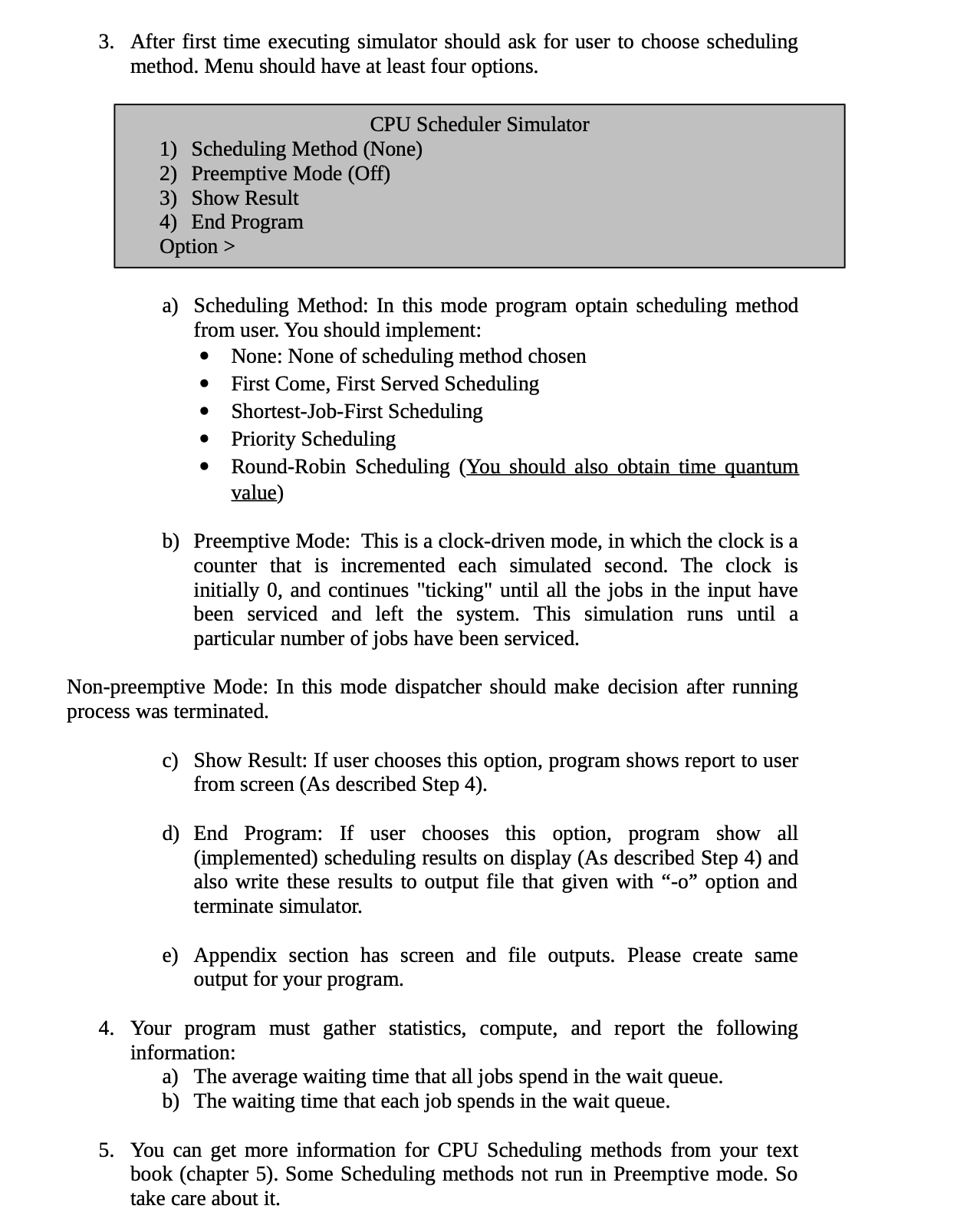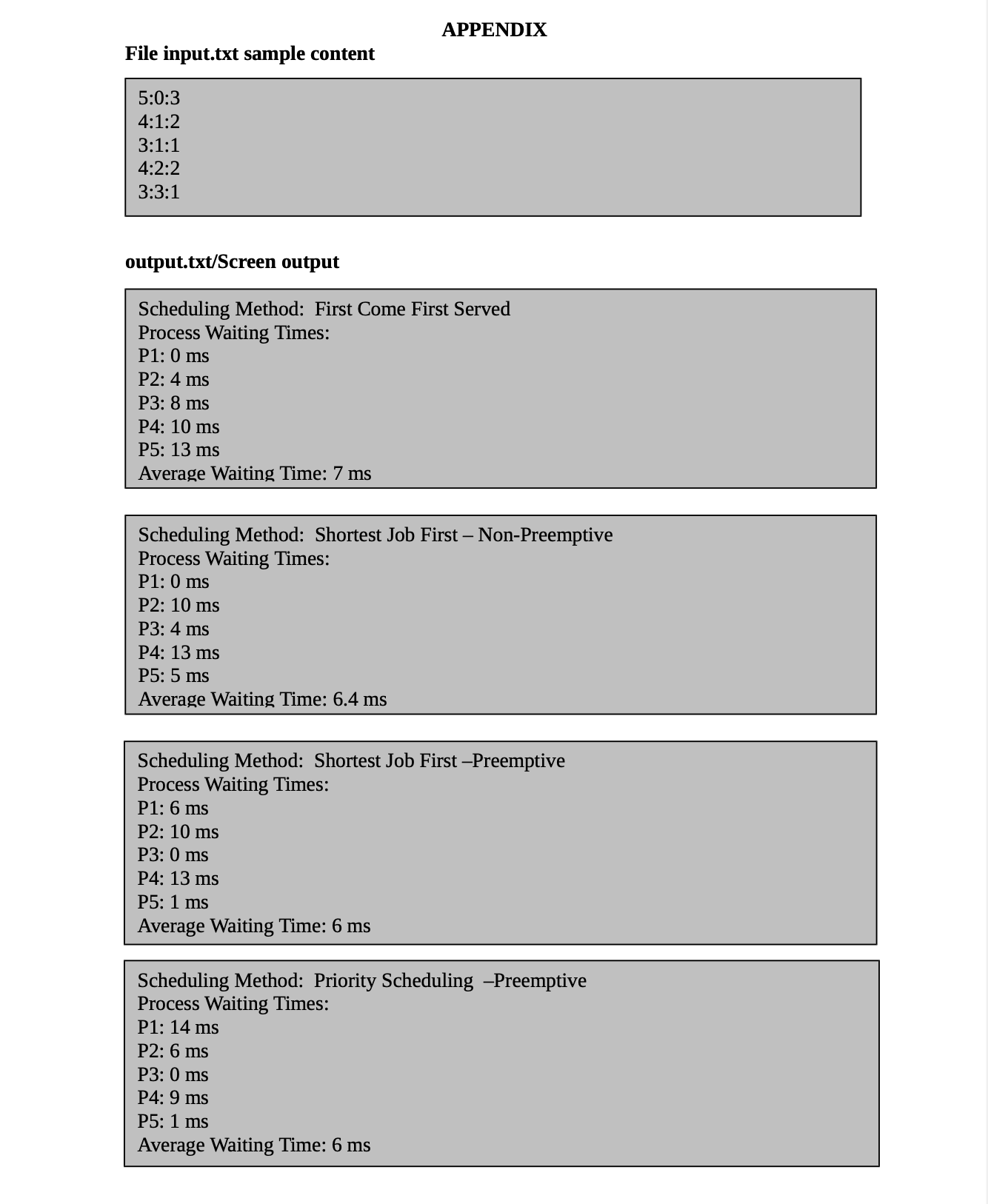Answered step by step
Verified Expert Solution
Question
1 Approved Answer
CPU Scheduler Simulator (I saw the same program on Cheeg but I need different code please to avoid plagiarism) Objectives: Your project is to write
CPU Scheduler Simulator (I saw the same program on Cheeg but I need different code please to avoid plagiarism)



 Objectives: Your project is to write a program that simulates the service of jobs (process) by the CPU of a multi-user computer. Inputs should be taken from text file with command arguments. And results also should be written to output file and screen. Recommendations \& Rules: - The application must be written in C/C++ programming language and must be compiled on GNU/Linux Operating Systems. - Don't use any special library for protocols when coding. Write your own functions if it's necessary. Only exemption is data structure functions that given in Data structures lecture. - You should commit changes on github system. Usually at least one time a day you should commit your code on github. - Unless otherwise explicitly specified, all written assignments or code that is submitted is to be entirely the student's own work. Using any code or copying any assignment from others is strictly prohibited without advance prior permission from the instructor. - All students' work is their own. Students who do share their work with others are as responsible for academic dishonesty as the student receiving the material. - Students who encourage others to cheat or plagiarize, or students who are aware of plagiarism or cheating and do not report it are also participating in academically dishonest behavior. - In this case (academically dishonest behavior), students to be punished with no grade. Project Details: 1. Program should have command argument options to get input data from a text file and command argument option for write output data. "-f" must be used for command argument and following text indicate input file name and "-o" for output file name. student@db: \$ ./cpe351 -f input.txt -o output.txt 2. This file should have three columns and unlimited rows. It must be text and fields should delimit by ":" character. Below table represent structure of this file Some data fields may not use at decision process so you can omits the values. But every process should have three of these values. At the Appendix section input.txt file given as example. 3. After first time executing simulator should ask for user to choose scheduling method. Menu should have at least four options. CPU Scheduler Simulator 1) Scheduling Method (None) 2) Preemptive Mode (Off) 3) Show Result 4) End Program Option > a) Scheduling Method: In this mode program optain scheduling method from user. You should implement: - None: None of scheduling method chosen - First Come, First Served Scheduling - Shortest-Job-First Scheduling - Priority Scheduling - Round-Robin Scheduling (You should also obtain time quantum value) b) Preemptive Mode: This is a clock-driven mode, in which the clock is a counter that is incremented each simulated second. The clock is initially 0 , and continues "ticking" until all the jobs in the input have been serviced and left the system. This simulation runs until a particular number of jobs have been serviced. on-preemptive Mode: In this mode dispatcher should make decision after running ocess was terminated. c) Show Result: If user chooses this option, program shows report to user from screen (As described Step 4). d) End Program: If user chooses this option, program show all (implemented) scheduling results on display (As described Step 4) and also write these results to output file that given with "-o" option and terminate simulator. e) Appendix section has screen and file outputs. Please create same output for your program. 4. Your program must gather statistics, compute, and report the following information: a) The average waiting time that all jobs spend in the wait queue. b) The waiting time that each job spends in the wait queue. 5. You can get more information for CPU Scheduling methods from your text book (chapter 5). Some Scheduling methods not run in Preemptive mode. So take care about it. File innut txt samnle content output.txt/Screen output Scheduling Method: First Come First Served Process Waiting Times: P1: 0ms P2: 4ms P3: 8ms P4: 10ms P5: 13ms Average Waiting Time: 7ms Scheduling Method: Shortest Job First - Non-Preemptive Process Waiting Times: P1: 0ms P2: 10ms P3: 4ms P4: 13ms P5: 5ms Average Waiting Time: 6.4ms Scheduling Method: Shortest Job First -Preemptive Process Waiting Times: P1: 6ms P2: 10ms P3: 0ms P4: 13ms P5: 1ms Average Waiting Time: 6ms Scheduling Method: Priority Scheduling -Preemptive Process Waiting Times: P1: 14ms P2: 6ms P3: 0ms P4: 9ms P5: 1ms Average Waiting Time: 6ms Scheduling Method: Priority Scheduling - Non-Preemptive Process Waiting Times: P1: 0ms P2: 10ms P3: 4ms P4: 13ms P5: 5ms Average Waiting Time: 6.4ms Scheduling Method: Round Robin Scheduling - time_quantum=2 Process Waiting Times: P1: 14ms P2: 9ms P3: 11ms P4: 11ms P5: 12ms Average Waiting Time: 11.4ms
Objectives: Your project is to write a program that simulates the service of jobs (process) by the CPU of a multi-user computer. Inputs should be taken from text file with command arguments. And results also should be written to output file and screen. Recommendations \& Rules: - The application must be written in C/C++ programming language and must be compiled on GNU/Linux Operating Systems. - Don't use any special library for protocols when coding. Write your own functions if it's necessary. Only exemption is data structure functions that given in Data structures lecture. - You should commit changes on github system. Usually at least one time a day you should commit your code on github. - Unless otherwise explicitly specified, all written assignments or code that is submitted is to be entirely the student's own work. Using any code or copying any assignment from others is strictly prohibited without advance prior permission from the instructor. - All students' work is their own. Students who do share their work with others are as responsible for academic dishonesty as the student receiving the material. - Students who encourage others to cheat or plagiarize, or students who are aware of plagiarism or cheating and do not report it are also participating in academically dishonest behavior. - In this case (academically dishonest behavior), students to be punished with no grade. Project Details: 1. Program should have command argument options to get input data from a text file and command argument option for write output data. "-f" must be used for command argument and following text indicate input file name and "-o" for output file name. student@db: \$ ./cpe351 -f input.txt -o output.txt 2. This file should have three columns and unlimited rows. It must be text and fields should delimit by ":" character. Below table represent structure of this file Some data fields may not use at decision process so you can omits the values. But every process should have three of these values. At the Appendix section input.txt file given as example. 3. After first time executing simulator should ask for user to choose scheduling method. Menu should have at least four options. CPU Scheduler Simulator 1) Scheduling Method (None) 2) Preemptive Mode (Off) 3) Show Result 4) End Program Option > a) Scheduling Method: In this mode program optain scheduling method from user. You should implement: - None: None of scheduling method chosen - First Come, First Served Scheduling - Shortest-Job-First Scheduling - Priority Scheduling - Round-Robin Scheduling (You should also obtain time quantum value) b) Preemptive Mode: This is a clock-driven mode, in which the clock is a counter that is incremented each simulated second. The clock is initially 0 , and continues "ticking" until all the jobs in the input have been serviced and left the system. This simulation runs until a particular number of jobs have been serviced. on-preemptive Mode: In this mode dispatcher should make decision after running ocess was terminated. c) Show Result: If user chooses this option, program shows report to user from screen (As described Step 4). d) End Program: If user chooses this option, program show all (implemented) scheduling results on display (As described Step 4) and also write these results to output file that given with "-o" option and terminate simulator. e) Appendix section has screen and file outputs. Please create same output for your program. 4. Your program must gather statistics, compute, and report the following information: a) The average waiting time that all jobs spend in the wait queue. b) The waiting time that each job spends in the wait queue. 5. You can get more information for CPU Scheduling methods from your text book (chapter 5). Some Scheduling methods not run in Preemptive mode. So take care about it. File innut txt samnle content output.txt/Screen output Scheduling Method: First Come First Served Process Waiting Times: P1: 0ms P2: 4ms P3: 8ms P4: 10ms P5: 13ms Average Waiting Time: 7ms Scheduling Method: Shortest Job First - Non-Preemptive Process Waiting Times: P1: 0ms P2: 10ms P3: 4ms P4: 13ms P5: 5ms Average Waiting Time: 6.4ms Scheduling Method: Shortest Job First -Preemptive Process Waiting Times: P1: 6ms P2: 10ms P3: 0ms P4: 13ms P5: 1ms Average Waiting Time: 6ms Scheduling Method: Priority Scheduling -Preemptive Process Waiting Times: P1: 14ms P2: 6ms P3: 0ms P4: 9ms P5: 1ms Average Waiting Time: 6ms Scheduling Method: Priority Scheduling - Non-Preemptive Process Waiting Times: P1: 0ms P2: 10ms P3: 4ms P4: 13ms P5: 5ms Average Waiting Time: 6.4ms Scheduling Method: Round Robin Scheduling - time_quantum=2 Process Waiting Times: P1: 14ms P2: 9ms P3: 11ms P4: 11ms P5: 12ms Average Waiting Time: 11.4ms Step by Step Solution
There are 3 Steps involved in it
Step: 1

Get Instant Access to Expert-Tailored Solutions
See step-by-step solutions with expert insights and AI powered tools for academic success
Step: 2

Step: 3

Ace Your Homework with AI
Get the answers you need in no time with our AI-driven, step-by-step assistance
Get Started


